Toleration
Toleration is the allowing, permitting, or acceptance of an action, idea, object, or person which one dislikes or disagrees with. Political scientist Andrew R. Murphy explains that "We can improve our understanding by defining "toleration" as a set of social or political practices and "tolerance" as a set of attitudes."[1]. Where Random House Dictionary defines tolerance as "a fair, objective, and permissive attitude toward those whose opinions, beliefs, practices, racial or ethnic origins, etc., differ from one's own;" toleration is the practice of applying those attitudes within a social or political setting.[2]
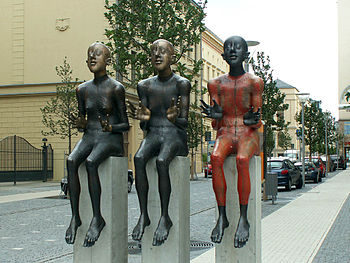
Both these concepts inherently contain the idea of alterity, the state of otherness.[3] Additional choices of how to respond to the "other," beyond toleration, do exist. Therefore, in some instances, toleration has been seen as ‘a flawed virtue’ because it concerns acceptance of things that were better overcome.[4] Toleration cannot, therefore, be defined as a universal good, and many of its applications and uses remain contested.[4]:2
Toleration may signify "no more than forbearance and the permission given by the adherents of a dominant religion for other religions to exist, even though the latter are looked on with disapproval as inferior, mistaken, or harmful."[5]. Historically, most incidents and writings pertaining to toleration involve the status of minority and dissenting viewpoints in relation to a dominant state religion.[6] However, religion is also sociological, and the practice of toleration has always had a political aspect as well.[7]:xiii
Toleration assumes there is a conflict over something important, something that cannot otherwise be resolved through normal negotiation without resorting to war or violence. As political lecturer Catriona McKinnon explains, when it comes to questions like what is "the best way to live, the right things to think, the ideal political society, or the true road to salvation, no amount of negotiation and bargaining will bring them to agreement without at least one party relinquishing the commitments that created the conflict in the first place. Such conflicts provide the circumstances of toleration... [and] are endemic in society."[8]:6 "The urgency and relevance of this issue is only too obvious: without tolerance, communities that value diversity, equality and peace could not persist (Vogt, 1997)."[4]:1
An overview of the history of toleration and different cultures in which toleration has been practiced, and the ways in which such a paradoxical concept has developed into a guiding one, illuminates its contemporary use as political, social, religious, and ethnic, applying to LGBT individuals and other minorities, and other connected concepts such as human rights.
Etymology
Originally from the Latin tolerans (present participle of tolerare; "to bear, endure, tolerate"), the word tolerance was first used in Middle French in the 14th century and in Early Modern English in the early 15th century.[9] The word toleration was first used in English in the 1510s to mean "permission granted by authority, licence" from the French tolération (originally from the Latin past participle stem of tolerare, tolerationem), moving towards the meaning of "forbearance, sufferance" in the 1580s.[10] The notion of religious toleration stems from 1609.[10]
In antiquity
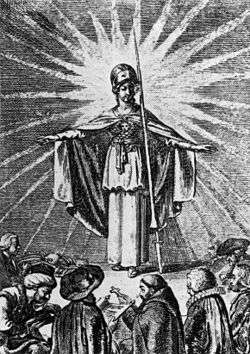
Religious toleration has been described as a "remarkable feature" of the Achaemenid Empire of Persia.[11] As reported in the Old Testament, king Cyrus the Great was believed to have released the Jews from captivity in 539–530 BCE, and permitted their return to their homeland.[12] Cyrus the Great assisted in the restoration of the sacred places of various cities.[11]
The Hellenistic city of Alexandria, founded 331 BCE, contained a large Jewish community which lived in peace with equivalently sized Greek and Egyptian populations. According to Michael Walzer, the city provided "a useful example of what we might think of as the imperial version of multiculturalism."[13]
The Roman Empire encouraged conquered peoples to continue worshipping their own gods. "An important part of Roman propaganda was its invitation to the gods of conquered territories to enjoy the benefits of worship within the imperium."[14] Christians were singled out for persecution because of their own rejection of Roman pantheism and refusal to honor the emperor as a god.[15] In 311 CE, Roman Emperor Galerius issued a general edict of toleration of Christianity, in his own name and in those of Licinius and Constantine I (who converted to Christianity the following year).[16]
Biblical sources
In the Old Testament, the books of Exodus, Leviticus and Deuteronomy make similar statements about the treatment of strangers. For example, Exodus 22:21 says: "Thou shalt neither vex a stranger, nor oppress him: for ye were strangers in the land of Egypt". These texts are frequently used in sermons to plead for compassion and tolerance of those who are different from us and less powerful.[17] Julia Kristeva elucidated a philosophy of political and religious toleration based on all of our mutual identities as strangers.[18]
The New Testament Parable of the Tares, which speaks of the difficulty of distinguishing wheat from weeds before harvest time, has also been invoked in support of religious toleration. In his "Letter to Bishop Roger of Chalons", Bishop Wazo of Liege (c. 985–1048) relied on the parable[19] to argue that "the church should let dissent grow with orthodoxy until the Lord comes to separate and judge them".[20]
Roger Williams, a Baptist theologian and founder of Rhode Island, used this parable to support government toleration of all of the "weeds" (heretics) in the world, because civil persecution often inadvertently hurts the "wheat" (believers) too. Instead, Williams believed it was God's duty to judge in the end, not man's. This parable lent further support to Williams' Biblical philosophy of a wall of separation between church and state as described in his 1644 book, The Bloody Tenent of Persecution.[21]
In the Middle Ages, Renaissance, and Reformation
In the Middle Ages, there were instances of toleration of particular groups. The Latin concept tolerantia was a "highly-developed political and judicial concept in medieval scholastic theology and canon law."[22] Tolerantia was used to "denote the self-restraint of a civil power in the face of" outsiders, like infidels, Muslims or Jews, but also in the face of social groups like prostitutes and lepers.[22] Heretics such as the Cathari, Waldensians, Jan Hus, and his followers, the Hussites, were persecuted.[23][24] Later theologians belonging or reacting to the Protestant Reformation began discussion of the circumstances under which dissenting religious thought should be permitted. Toleration "as a government-sanctioned practice" in Christian countries, "the sense on which most discussion of the phenomenon relies—is not attested before the sixteenth century".[25]
Unam sanctam and Extra Ecclesiam nulla salus
Centuries of Roman Catholic intoleration of other faiths was exemplified by Unam sanctam, a papal bull issued by Pope Boniface VIII on 18 November 1302. The Bull laid down dogmatic propositions on the unity of the Catholic Church, the necessity of belonging to it for eternal salvation (Extra Ecclesiam nulla salus), the position of the Pope as supreme head of the Church, and the duty thence arising of submission to the Pope in order to belong to the Church and thus to attain salvation. The bull ends, "Furthermore, we declare, we proclaim, we define that it is absolutely necessary for salvation that every human creature be subject to the Roman Pontiff."
Tolerance of the Jews
In Poland in 1264, the Statute of Kalisz was issued, guaranteeing freedom of religion for the Jews in the country.
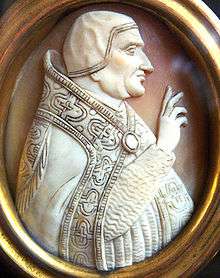
In 1348, Pope Clement VI (1291–1352) issued a bull pleading with Catholics not to murder Jews, whom they blamed for the Black Death. He noted that Jews died of the plague like anyone else, and that the disease also flourished in areas where there were no Jews. Christians who blamed and killed Jews had been "seduced by that liar, the Devil". He took Jews under his personal protection at Avignon, but his calls for other clergy to do so failed to be heeded.[26]
Johann Reuchlin (1455–1522) was a German humanist and a scholar of Greek and Hebrew who opposed efforts by Johannes Pfefferkorn, backed by the Dominicans of Cologne, to confiscate all religious texts from the Jews as a first step towards their forcible conversion to the Catholic religion.[27]
Despite occasional spontaneous episodes of pogroms and killings, as during the Black Death, Polish–Lithuanian Commonwealth was a relatively tolerant home for the Jews in the medieval period. In 1264, the Statute of Kalisz guaranteed safety, personal liberties, freedom of religion, trade, and travel to Jews. By the mid-16th century, the Polish–Lithuanian Commonwealth was home to 80% of the world's Jewish population. Jewish worship was officially recognized, with a Chief Rabbi originally appointed by the monarch. Jewish property ownership was also protected for much of the period, and Jews entered into business partnerships with members of the nobility.[28]
Vladimiri
Paulus Vladimiri (c. 1370–1435) was a Polish scholar and rector who at the Council of Constance in 1414, presented a thesis, Tractatus de potestate papae et imperatoris respectu infidelium (Treatise on the Power of the Pope and the Emperor Respecting Infidels). In it he argued that pagan and Christian nations could coexist in peace and criticized the Teutonic Order for its wars of conquest of native non-Christian peoples in Prussia and Lithuania. Vladimiri strongly supported the idea of conciliarism and pioneered the notion of peaceful coexistence among nations—a forerunner of modern theories of human rights. Throughout his political, diplomatic and university career, he expressed the view that a world guided by the principles of peace and mutual respect among nations was possible and that pagan nations had a right to peace and to possession of their own lands.
Erasmus
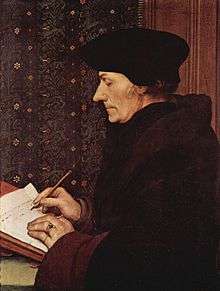
Desiderius Erasmus Roterodamus (1466–1536), was a Dutch Renaissance humanist and Catholic whose works laid a foundation for religious toleration. For example, in De libero arbitrio, opposing certain views of Martin Luther, Erasmus noted that religious disputants should be temperate in their language, "because in this way the truth, which is often lost amidst too much wrangling may be more surely perceived." Gary Remer writes, "Like Cicero, Erasmus concludes that truth is furthered by a more harmonious relationship between interlocutors."[29] Although Erasmus did not oppose the punishment of heretics, in individual cases he generally argued for moderation and against the death penalty. He wrote, "It is better to cure a sick man than to kill him."[30]
More
Saint Thomas More (1478–1535), Catholic Lord Chancellor of King Henry VIII and author, described a world of almost complete religious toleration in Utopia (1516), in which the Utopians "can hold various religious beliefs without persecution from the authorities."[31] However, More's work is subject to various interpretations, and it is not clear that he felt that earthly society should be conducted the same way as in Utopia. Thus, in his three years as Lord Chancellor, More actively approved of the persecution of those who sought to undermine the Catholic faith in England.[32]
Reformation
At the Diet of Worms (1521), Martin Luther refused to recant his beliefs citing freedom of conscience as his justification.[33] According to Historian Hermann August Winkler, the individual's freedom of conscience became the hallmark of Protestantism.[34] Luther was convinced that faith in Jesus Christ was the free gift of the Holy Spirit and could therefore not be forced on a person. Heresies could not be met with force, but with preaching the gospel revealed in the Bible. Luther: "Heretics should not be overcome with fire, but with written sermons." In Luther's view, the worldly authorities were entitled to expel heretics. Only if they undermine the public order, should they be executed.[35] Later proponents of tolerance such as Sebastian Franck and Sebastian Castellio cited Luther's position. He had overcome, at least for the Protestant territories and countries, the violent medieval criminal procedures of dealing with heretics. But Luther remained rooted in the Middle Ages insofar as he considered the Anabaptists' refusal to take oaths, do military service, and the rejection of private property by some Anabaptist groups to be a political threat to the public order which would inevitably lead to anarchy and chaos.[36] So Anabaptists were persecuted not only in Catholic but also in Lutheran and Reformed territories. However, a number of Protestant theologians such as John Calvin, Martin Bucer, Wolfgang Capito, and Johannes Brenz as well as Landgrave Philip of Hesse opposed the execution of Anabaptists.[37] Ulrich Zwingli demanded the expulsion of persons who did not accept the Reformed beliefs, in some cases the execution of Anabaptist leaders. The young Michael Servetus also defended tolerance since 1531, in his letters to Johannes Oecolampadius, but during those years some Protestant theologians such as Bucer and Capito publicly expressed they thought he should be persecuted.[38] The trial against Servetus, an Antitrinitarian, in Geneva was not a case of church discipline but a criminal procedure based on the legal code of the Holy Roman Empire. Denying the Trinity doctrine was long considered to be the same as atheism in all churches. The Anabaptists made a considerable contribution to the development of tolerance in the early-modern era by incessantly demanding freedom of conscience and standing up for it with their patient suffering.[39]
Castellio
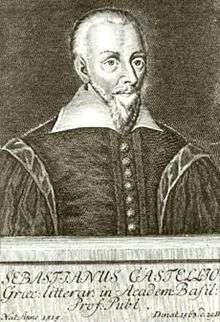
Sebastian Castellio (1515–1563) was a French Protestant theologian who in 1554 published under a pseudonym the pamphlet Whether heretics should be persecuted (De haereticis, an sint persequendi) criticizing John Calvin's execution of Michael Servetus: "When Servetus fought with reasons and writings, he should have been repulsed by reasons and writings." Castellio concluded: "We can live together peacefully only when we control our intolerance. Even though there will always be differences of opinion from time to time, we can at any rate come to general understandings, can love one another, and can enter the bonds of peace, pending the day when we shall attain unity of faith."[40] Castellio is remembered for the often quoted statement, "To kill a man is not to protect a doctrine, but it is to kill a man.[41]
Bodin
Jean Bodin (1530–1596) was a French Catholic jurist and political philosopher. His Latin work Colloquium heptaplomeres de rerum sublimium arcanis abditis ("The Colloqium of the Seven") portrays a conversation about the nature of truth between seven cultivated men from diverse religious or philosophical backgrounds: a natural philosopher, a Calvinist, a Muslim, a Roman Catholic, a Lutheran, a Jew, and a skeptic. All agree to live in mutual respect and tolerance.
Montaigne
Michel de Montaigne (1533–1592), French Catholic essayist and statesman, moderated between the Catholic and Protestant sides in the Wars of Religion. Montaigne's theory of skepticism led to the conclusion that we cannot precipitously decide the error of others' views. Montaigne wrote in his famous "Essais": "It is putting a very high value on one's conjectures, to have a man roasted alive because of them...To kill people, there must be sharp and brilliant clarity."[42]
Edict of Torda
In 1568, King John II Sigismund of Hungary, encouraged by his Unitarian Minister Francis David (Dávid Ferenc), issued the Edict of Torda decreeing religious toleration.
Maximilian II
In 1571, Holy Roman Emperor Maximilian II granted religious toleration to the nobles of Lower Austria, their families and workers.[43]
The Warsaw Confederation, 1573

The Polish–Lithuanian Commonwealth had a long tradition of religious freedom. The right to worship freely was a basic right given to all inhabitants of the Commonwealth throughout the 15th and early 16th centuries, however complete freedom of religion was officially recognized in the Polish–Lithuanian Commonwealth in 1573 in the Warsaw Confederation. The Commonwealth kept religious-freedom laws during an era when religious persecution was an everyday occurrence in the rest of Europe.[44]
The Warsaw Confederation was a private compact signed by representatives of all the major religions in Polish and Lithuanian society, in which they pledged each other mutual support and tolerance. The confederation was incorporated into the Henrican articles, which constituted a virtual Polish–Lithuanian constitution.
Edict of Nantes
The Edict of Nantes, issued on April 13, 1598, by Henry IV of France, granted Protestants—notably Calvinist Huguenots—substantial rights in a nation where Catholicism was the state religion. The main concern was civil unity;[45] The Edict separated civil law from religious rights, treated non-Catholics as more than mere schismatics and heretics for the first time, and opened a path for secularism and tolerance. In offering general freedom of conscience to individuals, the edict offered many specific concessions to the Protestants, such as amnesty and the reinstatement of their civil rights, including the right to work in any field or for the State, and to bring grievances directly to the king. The edict marked the end of the religious wars in France that tore apart the population during the second half of the 16th century.
The Edict of Nantes was revoked in 1685 by King Louis XIV with the Edict of Fontainebleau, leading to renewed persecution of Protestants in France. Although strict enforcement of the revocation was relaxed during the reign of Louis XV, it was not until 102 years later, in 1787, when Louis XVI signed the Edict of Versailles—known as the Edict of Tolerance—that civil status and rights to form congregations by Protestants were restored.[46]
In the Enlightenment
Beginning in the Enlightenment commencing in the 1600s, politicians and commentators began formulating theories of religious toleration and basing legal codes on the concept. A distinction began to develop between civil tolerance, concerned with "the policy of the state towards religious dissent".,[47] and ecclesiastical tolerance, concerned with the degree of diversity tolerated within a particular church.[48]
Milton

John Milton (1608–1674), English Protestant poet and essayist, called in the Areopagitica for "the liberty to know, to utter, and to argue freely according to conscience, above all liberties" (applied, however, only to the conflicting Protestant denominations, and not to atheists, Jews, Muslims or even Catholics). "Milton argued for disestablishment as the only effective way of achieving broad toleration. Rather than force a man's conscience, government should recognize the persuasive force of the gospel."[49]
In the American colonies

In 1636, Roger Williams and companions at the foundation of Rhode Island entered into a compact binding themselves "to be obedient to the majority only in civil things". Williams spoke of "democracie or popular government."[51] Lucian Johnston writes, "Williams' intention was to grant an infinitely greater religious liberty than what existed anywhere in the world outside of the Colony of Maryland." In 1663, Charles II granted the colony a charter guaranteeing complete religious toleration.[52]
Also in 1636, Congregationalist Thomas Hooker and a group of companions founded Connecticut. They combined the democratic form of government that had been developed by the Separatist Congregationalists in Plymouth Colony (Pilgrim Fathers) with unlimited freedom of conscience. Like Martin Luther, Hooker argued that as faith in Jesus Christ was the free gift of the Holy Spirit it could not be forced on a person.[53]
In 1649 Maryland passed the Maryland Toleration Act, also known as the Act Concerning Religion, a law mandating religious tolerance for Trinitarian Christians only (excluding Nontrinitarian faiths). Passed on September 21, 1649 by the assembly of the Maryland colony, it was the first law requiring religious tolerance in the British North American colonies. The Calvert family sought enactment of the law to protect Catholic settlers and some of the other denominations that did not conform to the dominant Anglicanism of England and her colonies.
In 1657, New Amsterdam, governed by Dutch Calvinists, granted religious toleration to Jews.[54] They had fled from Portuguese persecution in Brazil.[55]
In the Province of Pennsylvania, William Penn and his fellow Quakers heavily imprinted their religious values of toleration on the Pennsylvania government. The Pennsylvania 1701 Charter of Privileges extended religious freedom to all monotheists, and government was open to all Christians.
Spinoza
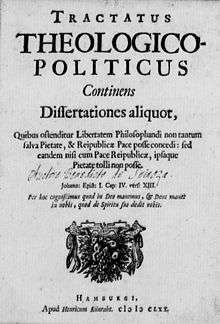
Baruch Spinoza (1632–1677) was a Dutch Jewish philosopher. He published the Theological-Political Treatise anonymously in 1670, arguing (according to the Stanford Encyclopedia of Philosophy) that "the freedom to philosophize can not only be granted without injury to piety and the peace of the Commonwealth, but that the peace of the Commonwealth and Piety are endangered by the suppression of this freedom", and defending, "as a political ideal, the tolerant, secular, and democratic polity". After interpreting certain Biblical texts, Spinoza opted for tolerance and freedom of thought in his conclusion that "every person is in duty bound to adapt these religious dogmas to his own understanding and to interpret them for himself in whatever way makes him feel that he can the more readily accept them with full confidence and conviction."[56]
Locke
English philosopher John Locke (1632–1704) published A Letter Concerning Toleration in 1689. Locke's work appeared amidst a fear that Catholicism might be taking over England, and responds to the problem of religion and government by proposing religious toleration as the answer. Unlike Thomas Hobbes, who saw uniformity of religion as the key to a well-functioning civil society, Locke argued that more religious groups actually prevent civil unrest. In his opinion, civil unrest results from confrontations caused by any magistrate's attempt to prevent different religions from being practiced, rather than tolerating their proliferation. However, Locke denies religious tolerance for Catholics, for political reasons, and also for atheists because "Promises, covenants, and oaths, which are the bonds of human society, can have no hold upon an atheist". A passage Locke later added to An Essay Concerning Human Understanding questioned whether atheism was necessarily inimical to political obedience.
Bayle

Pierre Bayle (1647–1706) was a French Protestant scholar and philosopher who went into exile in Holland. In his "Dictionnaire Historique et Critique" and "Commentaire Philosophique" he advanced arguments for religious toleration (though, like some others of his time, he was not anxious to extend the same protection to Catholics he would to differing Protestant sects). Among his arguments were that every church believes it is the right one so "a heretical church would be in a position to persecute the true church". Bayle wrote that "the erroneous conscience procures for error the same rights and privileges that the orthodox conscience procures for truth."[57]
Bayle was repelled by the use of scripture to justify coercion and violence: "One must transcribe almost the whole New Testament to collect all the Proofs it affords us of that Gentleness and Long-suffering, which constitute the distinguishing and essential Character of the Gospel." He did not regard toleration as a danger to the state, but to the contrary: "If the Multiplicity of Religions prejudices the State, it proceeds from their not bearing with one another but on the contrary endeavoring each to crush and destroy the other by methods of Persecution. In a word, all the Mischief arises not from Toleration, but from the want of it."[58]
Toleration Act 1688
The Toleration Act 1688 adopted by the English Parliament allowed freedom of worship to Nonconformists who had pledged to the oaths of Allegiance and Supremacy and rejected transubstantiation. The Nonconformists were Protestants who dissented from the Church of England such as Baptists and Congregationalists. They were allowed their own places of worship and their own teachers, if they accepted certain oaths of allegiance. The Act, however, did not apply to Catholics and non-trinitarians, and continued the existing social and political disabilities for Dissenters, including their exclusion from political office and from the universities of Oxford and Cambridge.
Voltaire
_-_Stierch.jpg)
François-Marie Arouet, the French writer, historian and philosopher known as Voltaire (1694–1778) published his Treatise on Toleration in 1763. In it he attacked religious views, but also said, "It does not require great art, or magnificently trained eloquence, to prove that Christians should tolerate each other. I, however, am going further: I say that we should regard all men as our brothers. What? The Turk my brother? The Chinaman my brother? The Jew? The Siam? Yes, without doubt; are we not all children of the same father and creatures of the same God?"[59] On the other hand, Voltaire in his writings on religion was spiteful and intolerant of the practice of the Christian religion, and Orthodox rabbi Joseph Telushkin has claimed that the most significant of Enlightenment hostility against Judaism was found in Voltaire.[60]
Lessing
Gotthold Ephraim Lessing (1729–1781), German dramatist and philosopher, trusted in a "Christianity of Reason", in which human reason (initiated by criticism and dissent) would develop, even without help by divine revelation. His plays about Jewish characters and themes, such as "Die Juden" and "Nathan der Weise", "have usually been considered impressive pleas for social and religious toleration".[61] The latter work contains the famous parable of the three rings, in which three sons represent the three Abrahamic religions, Christianity, Judaism, and Islam. Each son believes he has the one true ring passed down by their father, but judgment on which is correct is reserved to God.[62]
Declaration of the Rights of Man and the Citizen
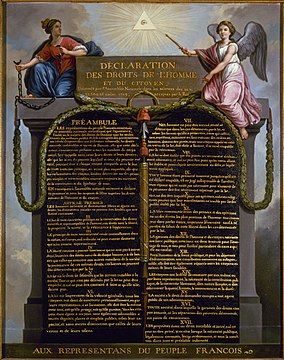
The Declaration of the Rights of Man and the Citizen (1789), adopted by the National Constituent Assembly during the French Revolution, states in Article 10: "No-one shall be interfered with for his opinions, even religious ones, provided that their practice does not disturb public order as established by the law." ("Nul ne doit être inquiété pour ses opinions, mêmes religieuses, pourvu que leur manifestation ne trouble pas l'ordre public établi par la loi.")[63]
The First Amendment to the United States Constitution
The First Amendment to the United States Constitution, ratified along with the rest of the Bill of Rights on December 15, 1791, included the following words: "Congress shall make no law respecting an establishment of religion, or prohibiting the free exercise thereof..." In 1802, Thomas Jefferson wrote a letter to the Danbury Baptists Association in which he said: "...I contemplate with sovereign reverence that act of the whole American people which declared that their legislature should 'make no law respecting an establishment of religion, or prohibiting the free exercise thereof,' thus building a wall of separation between Church & State."[64]
In the nineteenth century
The process of legislating religious toleration went unevenly forward, while philosophers continued to discuss the underlying rationale.
Roman Catholic Relief Act
The Roman Catholic Relief Act 1829 adopted by the Parliament in 1829 repealed the last of the criminal laws (TEST ACTS) aimed at Catholic citizens of Great Britain.
Syllabus of Errors
The Syllabus of Errors was issued by Pope Pius IX in 1864. It condemns 80 errors or heresies, including the following propositions regarding religious toleration:
77. In the present day it is no longer expedient that the Catholic religion should be held as the only religion of the State, to the exclusion of all other forms of worship. 78. Hence it has been wisely decided by law, in some Catholic countries, that persons coming to reside therein shall enjoy the public exercise of their own peculiar worship. 79. Moreover, it is false that the civil liberty of every form of worship, and the full power, given to all, of overtly and publicly manifesting any opinions whatsoever and thoughts, conduce more easily to corrupt the morals and minds of the people, and to propagate the pest of indifferentism.
Mill
John Stuart Mill's arguments in "On Liberty" (1859) in support of the freedom of speech were phrased to include a defense of religious toleration:
Let the opinions impugned be the belief of God and in a future state, or any of the commonly received doctrines of morality... But I must be permitted to observe that it is not the feeling sure of a doctrine (be it what it may) which I call an assumption of infallibility. It is the undertaking to decide that question for others, without allowing them to hear what can be said on the contrary side. And I denounce and reprobate this pretension not the less if it is put forth on the side of my most solemn convictions.[65]
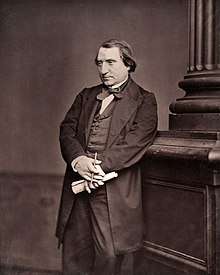
Renan
In his 1882 essay "What is a Nation?", French historian and philosopher Ernest Renan proposed a definition of nationhood based on "a spiritual principle" involving shared memories, rather than a common religious, racial or linguistic heritage. Thus members of any religious group could participate fully in the life of the nation. "You can be French, English, German, yet Catholic, Protestant, Jewish, or practicing no religion".[66]
In the twentieth century
In 1948, the United Nations General Assembly adopted Article 18 of the Universal Declaration of Human Rights, which states:
Everyone has the right to freedom of thought, conscience and religion; this right includes freedom to change his religion or belief, and freedom, either alone or in community with others and in public or private, to manifest his religion or belief in teaching, practice, worship and observance[67]
Even though not formally legally binding, the Declaration has been adopted in or influenced many national constitutions since 1948. It also serves as the foundation for a growing number of international treaties and national laws and international, regional, national and sub-national institutions protecting and promoting human rights including the freedom of religion.
In 1965, The Roman Catholic Church Vatican II Council issued the decree Dignitatis humanae (Religious Freedom) that states that all people must have the right to religious freedom.[68] The Catholic 1983 Code of Canon Law states:
Can. 748 §1. All persons are bound to seek the truth in those things which regard God and his Church and by virtue of divine law are bound by the obligation and possess the right of embracing and observing the truth which they have come to know. §2. No one is ever permitted to coerce persons to embrace the Catholic faith against their conscience.
In 1986, the first World Day of Prayer for Peace was held in Assisi. Representatives of one hundred and twenty different religions came together for prayer.[69]
In 1988, in the spirit of Glasnost, Soviet premier Mikhail Gorbachev promised increased religious toleration.[70]
In other religions
Other major world religions also have texts or practices supporting the idea of religious toleration.
Hindu religion
The Rigveda says Ekam Sath Viprah Bahudha Vadanti which translates to "The truth is One, but sages call it by different Names".[71] Consistent with this tradition, India chose to be a secular country even though it was divided partitioning on religious lines. Whatever intolerance Hindu scholars displayed towards other religions was subtle and symbolic and most likely was done to present a superior argument in defence of their own faith. Traditionally, Hindus showed their intolerance by withdrawing and avoiding contact with those whom they held in contempt, instead of using violence and aggression to strike fear in their hearts. Hinduism is perhaps the only religion in the world which showed remarkable tolerance towards other religions in difficult times and under testing conditions. Even Buddhism, which spread in India mostly through negative campaigns against Hinduism, cannot claim that credit. Criticizing other religions and showing them in poor light to attract converts to its own fold was never an approved practice in Hinduism.[72]
Pluralism and tolerance of diversity are built into Hindu theology India's long history is a testimony to its tolerance of religious diversity. Christianity came to India with St. Thomas in the first century CE, long before it became popular in the West. Judaism came to India after the Jewish temple was destroyed by the Romans in 70 CE and the Jews were expelled from their homeland. In a recent book titled "Who are the Jews of India?" (University of California Press, 2000), author Nathan Katz observes that India is the only country where the Jews were not persecuted. The Indian chapter is one of the happiest of the Jewish Diaspora. Both Christians and Jews have existed in a predominant Hindu India for centuries without being persecuted. Zoroastrians from Persia (present day Iran) entered India in the 7th century to flee Islamic conquest. They are known as Parsis in India. The Parsis are an affluent community in the city of Mumbai. Once treated as foreigners, they remain a minority community, yet still housing the richest business families in India; for example, the Tata family controls a huge industrial empire in various parts of the country. Mrs. Indira Gandhi, the powerful Prime Minister of India (1966–77; 1980–84), was married to Feroz Gandhi, a Parsi (no relation to Mahatma Gandhi). [73]
Islam
The Qur'an, albeit having given importance to its 'true believers', commands its followers to tolerate 'the people of all faiths and communities' and to let them command their dignity, without breaking the Shariah law.
Certain verses of the Qur'an were interpreted to create a specially tolerated status for People of the Book, Jewish and Christian believers in the Old and New Testaments considered to have been a basis for Islamic religion:
Verily! Those who believe and those who are Jews and Christians, and Sabians, whoever believes in God and the Last Day and do righteous good deeds shall have their reward with their Lord, on them shall be no fear, nor shall they grieve.[74]
Under Islamic law, Jews and Christians were considered dhimmis, a legal status inferior to that of a Muslim but superior to that of other non-Muslims.
Jewish communities in the Ottoman Empire held a protected status and continued to practice their own religion, as did Christians, though both were subject to additional restrictions, such as restrictions on the areas where they could live or work or in clothing,[75] and both had to pay additional taxes.[76] Yitzhak Sarfati, born in Germany, became the Chief Rabbi of Edirne and wrote a letter inviting European Jews to settle in the Ottoman Empire, in which he asked: "Is it not better for you to live under Muslims than under Christians?'".[77] Sultan Beyazid II (1481–1512), issued a formal invitation to the Jews expelled from Catholic Spain and Portugal, leading to a wave of Jewish immigration.
According to Michael Walzer:
The established religion of the [Ottoman] empire was Islam, but three other religious communities—Greek Orthodox, Armenian Orthodox, and Jewish—were permitted to form autonomous organizations. These three were equal among themselves, without regard to their relative numerical strength. They were subject to the same restrictions vis-à-vis Muslims—with regard to dress, proselytizing, and intermarriage, for example—and were allowed the same legal control over their own members.[78]
Buddhism
Although Bhikkhu Bodhi states that the Buddha taught "the path to the supreme goal of the holy life is made known only in his own teaching", Buddhists have nevertheless shown significant tolerance for other religions: "Buddhist tolerance springs from the recognition that the dispositions and spiritual needs of human beings are too vastly diverse to be encompassed by any single teaching, and thus that these needs will naturally find expression in a wide variety of religious forms."[79] James Freeman Clarke said in Ten Great Religions (1871): "The Buddhists have founded no Inquisition; they have combined the zeal which converted kingdoms with a toleration almost inexplicable to our Western experience."[80]
The Edicts of Ashoka issued by King Ashoka the Great (269–231 BCE), a Buddhist, declared ethnic and religious tolerance. His Edict in the 12th main stone writing of Girnar on the third century B.C. which state that "Kings accepted religious tolerance and that Emperor Ashoka maintained that no one would consider his / her is to be superior to other and rather would follow a path of unity by accuring the essence of other religions".[81]
However, Buddhism has also had controversies regarding toleration. See Dorje Shugden Controversy. In addition, the question of possible intolerance among Buddhists in Sri Lanka and Myanmar, primarily against Muslims, has been raised by Paul Fuller.[82]
Tolerance and digital technologies
The development of new digital technologies has resulted in an exponential growth in the volume of information and knowledge available, and made them more readily accessible to greater numbers of people throughout the world. As such, information and communication technologies can play an essential role in the sharing of knowledge and expertise in the service of sustainable development and in a spirit of solidarity. And yet, for many observers, the world is witnessing rising levels of ethnic, cultural and religious intolerance, often using the same communication technologies for ideological and political mobilization to promote exclusivist worldviews. This mobilization often leads to further criminal and political violence and to armed conflict.[83] This also leads to new modes of intolerance such as cyberbullying.
Modern analyses and critiques
Contemporary commentators have highlighted situations in which toleration conflicts with widely held moral standards, national law, the principles of national identity, or other strongly held goals. Michael Walzer notes that the British in India tolerated the Hindu practice of suttee (ritual burning of a widow) until 1829. On the other hand, the United States declined to tolerate the Mormon practice of polygamy.[84] The French head scarf controversy represents a conflict between religious practice and the French secular ideal.[85] Toleration of the Romani people in European countries is a continuing issue.[86]
Modern definition
Historian Alexandra Walsham notes that the modern understanding of the word "toleration" may be very different from its historic meaning.[87] Toleration in modern parlance has been analyzed as a component of a liberal or libertarian view of human rights. Hans Oberdiek writes, "As long as no one is harmed or no one's fundamental rights are violated, the state should keep hands off, tolerating what those controlling the state find disgusting, deplorable or even debased. This for a long time has been the most prevalent defense of toleration by liberals... It is found, for example, in the writings of American philosophers John Rawls, Robert Nozick, Ronald Dworkin, Brian Barry, and a Canadian, Will Kymlicka, among others."[88]
Isaiah Berlin attributes to Herbert Butterfield the notion that "toleration... implies a certain disrespect. I tolerate your absurd beliefs and your foolish acts, though I know them to be absurd and foolish. Mill would, I think, have agreed."[89]
John Gray states that "When we tolerate a practice, a belief or a character trait, we let something be that we judge to be undesirable, false or at least inferior; our toleration expresses the conviction that, despite its badness, the object of toleration should be left alone."[90] However, according to Gray, "new liberalism—the liberalism of Rawls, Dworkin, Ackerman and suchlike" seems to imply that "it is wrong for government to discriminate in favour of, or against, any form of life animated by a definite conception of the good".[91]
John Rawls' "theory of 'political liberalism' conceives of toleration as a pragmatic response to the fact of diversity". Diverse groups learn to tolerate one another by developing "what Rawls calls 'overlapping consensus': individuals and groups with diverse metaphysical views or 'comprehensive schemes' will find reasons to agree about certain principles of justice that will include principles of toleration".[92]
Herbert Marcuse wrote A Critique of Pure Tolerance in 1965 where he argued that the "pure tolerance" that permits all favors totalitarianism, democracy, and tyranny of the majority, and insisted the "repressive tolerance" against them.
Tolerating the intolerant
Walzer, Karl Popper[93] and John Rawls[94] have discussed the paradox of tolerating intolerance. Walzer asks "Should we tolerate the intolerant?" He notes that most minority religious groups who are the beneficiaries of tolerance are themselves intolerant, at least in some respects.[95] Rawls argues that an intolerant sect should be tolerated in a tolerant society unless the sect directly threatens the security of other members of the society. He links this principle to the stability of a tolerant society, in which members of an intolerant sect in a tolerant society will, over time, acquire the tolerance of the wider society.
Other criticisms and issues
Toleration has been described as undermining itself via moral relativism: "either the claim self-referentially undermines itself or it provides us with no compelling reason to believe it. If we are skeptical about knowledge, then we have no way of knowing that toleration is good."[96]
Ronald Dworkin argues that in exchange for toleration, minorities must bear with the criticisms and insults which are part of the freedom of speech in an otherwise tolerant society.[97] Dworkin has also questioned whether the United States is a "tolerant secular" nation, or is re-characterizing itself as a "tolerant religious" nation, based on the increasing re-introduction of religious themes into conservative politics. Dworkin concludes that "the tolerant secular model is preferable, although he invited people to use the concept of personal responsibility to argue in favor of the tolerant religious model."[98]
In The End of Faith, Sam Harris asserts that society should be unwilling to tolerate unjustified religious beliefs about morality, spirituality, politics, and the origin of humanity, especially beliefs which promote violence.
See also
- Anekantavada
- Christian debate on persecution and toleration
- Death Camp of Tolerance
- Freedom From Religion Foundation
- International Day for Tolerance
- Islam and other religions
- Multifaith space
- Ontario Consultants on Religious Tolerance
- Paradox of tolerance
- Religious discrimination
- Religious intolerance
- Religious liberty
- Religious persecution
- Religious pluralism
- Repressive Tolerance
- Secular state
- Separation of church and state
- Staind
- Status of religious freedom by country
- Zero tolerance
Sources
![]()
References
- Murphy, Andrew R. (1997). "Tolerance, Toleration, and the Liberal Tradition". Polity. The University of Chicago Press Journals. 29 (4): 593–623. doi:10.2307/3235269. JSTOR 3235269.
- "Tolerance" in Random House Dictionary (via dictionary.reference.com).
- van Doorn, Marjoka (October 2014). "The nature of tolerance and the social circumstances in which it emerges". 62. Current Sociology. pp. 905–927.
- van Doorn, Marjoka (2012). "Tolerance" (PDF). Sociopedia. SAGE.
- Perez Zagorin, How the Idea of Religious Toleration Came to the West (Princeton: Princeton University Press 2003) ISBN 0691092702, pp. 5–6, quoting D.D. Raphael et al.
- Joachim Vahland, 'Toleranzdiskurse', Zeno no. 37 (2017), pp. 7–25
- Gervers, Peter; Gervers, Michael; Powell, James M., eds. (2001). Tolerance and Intolerance: Social Conflict in the Age of the Crusades. Syracuse University Press. ISBN 9780815628699.
- McKinnon, Catriona (2006). Toleration: A Critical Introduction. New York: Routledge. ISBN 0-415-32289-8.
- "tolerance (n.)". Online Etymology Dictionary. Retrieved 19 November 2018.
- "toleration (n.)". Online Etymology Dictionary. Retrieved 19 November 2018.
- Fisher, William Bayne; Gershevitch, I. (1968). The Cambridge History of Iran. Cambridge University Press. p. 412. ISBN 9780521200912.
- "Book of Ezra | King James Bible". Kingjamesbibletrust.org. Archived from the original on May 10, 2011. Retrieved March 21, 2011.
- Walzer, Michael (1997). On Toleration. New Haven: Yale University Press. p. 17. ISBN 978-0300076004.
- Witte, John Jr. and Johan D. van de Vyver, Religious Human Rights in Global Perspective (The Hague: Kluwer 1996) p. 74 ISBN 9041101764
- Logan, Donald F., A history of the church in the Middle Ages (New York:Routledge, 2002) ISBN 0415132894, p. 8
- "Valerius Maximianus Galerius", Karl Hoeber, Catholic Encyclopedia 1909 Ed, retrieved 1 June 2007.
- February 5, 2008 posting by Rabbi David Kominsky ...For You Were Strangers in the Land of Egypt. Accessed January 25, 2011
- Walzer, Michael On Toleration (New Haven: Yale University Press 1997) pp. 80–81
- Richard Landes (2000). "The Birth of Heresy: A Millennial Phenomenon". Journal of Religious History. 24 (1): 26–43. doi:10.1111/1467-9809.00099.
- Jeffrey Burton Russell, Dissent and Order in the Middle Ages: The Search for Legitimate Authority (New York: Twayne Publishers 1992), p. 23
- James P. Byrd (2002). The challenges of Roger Williams: religious liberty, violent persecution, and the Bible. Mercer University Press. ISBN 978-0865547711. Retrieved 15 June 2011.
- Walsham 2006: 234.
- Ellwood, Robert S. and Gregory D. Alles, eds. (2007), The Encyclopedia of World Religions, New York, p. 431
- Fudge, Thomas A. (2013), The Trial of Jan Hus. Medieval Heresy and Criminal Procedures, Oxford University Press, New York
- Drake, H.A. (November 1996). "Lambs into Lions: Explaining Early Christian Intolerance". Past & Present. 153 (153): 3–36. doi:10.1093/past/153.1.3. JSTOR 651134.
- Tuchman, Barbara, A Distant Mirror: The Calamitous 14th Century (New York: Alfred A. Knopf 1978), p. 113
- Rummel, Erika, "The case against Johann Reuchlin" (pp. iv–xv) University of Toronto Press, 2002 ISBN 0802084842, 978-0802084842.
- Poland. Jewish Virtual Library. Retrieved on 2011-06-15.
- Remer, Gary, Humanism and the Rhetoric of Toleration (University Park: University of Pennsylvania Press 1996) p. 95 ISBN 0271028114
- James Anthony Froude; Desiderius Erasmus (1894). Life and letters of Erasmus: lectures delivered at Oxford 1893–94. Longmans, Green. pp. 359–. Retrieved 15 June 2011.
- Marius, Richard Thomas More: a biography (Cambridge, Ma: Harvard University press, 1999) p. 175 ISBN 0674885252
- Marius, Richard Thomas More: a biography (Cambridge, Ma: Harvard University press, 1999) p. 386 ISBN 0674885252
- Olmstead, Clifton E. (1960), History of Religion in the United States, Englewood Cliffs, NJ, p. 5
- Winkler, Hermann August (2012), Geschichte des Westens. Von den Anfängen in der Antike bis zum 20. Jahrhundert, Third, Revised Edition, Munich (Germany), p. 152
- Ohst, Martin (2005), Toleranz/ Intoleranz, in Die Religion in Geschichte und Gegenwart, Fourth Edition, Tübingen (Germany), Volume 8, col. 463
- Heinrich Bornkamm (1962), Toleranz. In der Geschichte des Christentums, in Die Religion in Geschichte und Gegenwart, Third Edition, Tübingen (Germany), Vol. VI, col. 937–38
- Karl Heussi (1957), Kompendium der Kirchengeschichte, Eleventh Edition, Tübingen (Germany), pp. 316, 328
- Gonzalez Echeverría, Fco Javier (2012). El Amor a la Verdad. Vida y Obra de Miguel Servet p. 256. "Inherent of human condition is the sickness of believing the rest are impostors and heathen, and not ourselves, because nobody recognizes his own mistakes [..] If one must condemn everyone that misses in a particular point then every mortal would have to be burnt a thousand times. The apostles and Luther himself have been mistaken [..] If I have taken the word, by any reason, it has been because I think it is grave to kill men, under the pretext that they are mistaken on the interpretation of some point, for we know that even the chosen ones are not exempt from sometimes being wrong" (Michael Servetus)
- Heinrich Bornkamm (1962), col. 939
- Zweig, Stefan (1951). Erasmus; The Right to Heresy: Castellio against Calvin. London: Cassell. p. 312. OCLC 24340377.
- Sebastian Castellio, Contra libellum, # 77, Vaticanus.
- E.M. Curley, "Skepticism and Toleration: the Case of Montaigne", Accessed February 27, 2011
- Grossman, Walter (1979). "Toleration – Exercitium Religionis Privatum". Journal of the History of Ideas. 40 (1): 129–34. doi:10.2307/2709265. JSTOR 2709265.
-
- Zamoyski, Adam. The Polish Way. New York: Hippocrene Books, 1987
- In 1898 the tricentennial celebrated the Edict as the foundation of the coming Age of Toleration; the 1998 anniversary, by contrast, was commemorated with a book of essays under the evocatively ambivalent title, Coexister dans l'intolérance (Michel Grandjean and Bernard Roussel, editors, Geneva, 1998).
- Encyclopedia of the Age of Political Ideals, Edict of Versailles (1787) Archived 2012-07-14 at the Wayback Machine, downloaded 29 January 2012
- John Coffey, Persecution and Toleration in Protestant England, 1558–1689. Longman Publishing Group (2000). ISBN 0582304652. p. 11
- Coffey, p. 12
- Hunter, William Bridges A Milton Encyclopedia, Volume 8(East Brunswick, NJ: Associated University Presses, 1980) pp. 71–72 ISBN 0838718418
- "Rudolph II", Encyclopædia Britannica 15 Edition, retrieved 1 June 2007.
- Heinrich August Winkler, Geschichte des Westens. Von den Anfängen in der Antike bis zum 20. Jahrhundert, Third Edition, 2012, Munich (Germany), p. 262
- Johnston, Lucian, Religious Liberty in Maryland and Rhode Island (Brooklyn: International Catholic Truth Society, 1903), p. 30, 38
- Clifton E. Olmstead, History of Religion in the United States, 1960, Englewood Cliffs, NJ, pp. 74–75
- Hasia R. Diner, The Jews of the United States, 1654 to 2000, 2004, University of California Press, ISBN 0520248481, pp. 13–15
- Clifton E. Olmsted (1960) p. 124
- "Barcuch Spinoza", revised June 2008, Stanford Encyclopedia of Philosophy, Accessed February 25, 2011
- "Pierre Bayle", Stanford Encyclopedia of Philosophy, updated August 19, 2008. Accessed March 6, 2011
- Joseph LoConte, "The Golden Rule of Toleration". Accessed March 6, 2011
- Voltaire A Treatise on Toleration Archived 2006-01-07 at the Wayback Machine (1763)
- Prager, D; Telushkin, J. Why the Jews?: The Reason for Antisemitism. New York: Simon & Schuster, 1983. pp. 128–29.
- R. Robertson (1998). "'Dies Hohe Lied der Duldung'? The Ambiguities of Toleration in Lessing's Die Juden and Nathan der Weise". The Modern Language Review. 93 (1): 105–120. doi:10.2307/3733627. JSTOR 3733627.
- Dirk Martin Grube, "Gotthold Ephraim Lessing's Ring Parable: An Enlightenment Voice on Religious Tolerance", in Boeve, Lieven, Faith in the Enlightenment? The critique of the Enlightenment revisited (New York: Rodopi 2006) pp. 39ff ISBN 978-90-420-2067-2
- "Déclaration des droits de l'Homme et du citoyen de 1789". Accessed March 22, 2011
- Jefferson's Letter to the Danbury Baptists (June 1998) – Library of Congress Information Bulletin. Loc.gov. Retrieved on 2011-06-15.
- John Stuart Mill (1806–1873) “On Liberty” 1859. ed. Gertrude Himmelfarb, UK: Penguin, 1985, pp. 83–84
- Ernest Renan, "Qu'est-ce qu'une nation?", conference faite en Sorbonne, le 11 Mars 1882. Accessed January 13, 2011
- "The Universal Declaration of Human Rights", United Nations 1948, retrieved 1 June 2007.
- Dignitatis humanae, Decree on Religious Freedom, 1965, retrieved 1 June 2007.
- "Address of John Paul II to the Representatives of the Christian Churches and Ecclesial Communities and of the World Religions" (1986) retrieved 1 June 2007.
- "Russia", Encyclopædia Britannica. Retrieved on 2011-06-15.
- "Hinduism – a general introduction". Religioustolerance.org. Retrieved 2012-06-21.
- "evidence of tolerance". Jayaram V/Aniket Patil. Retrieved 2014-08-17.
- "Religious Tolerance and Hinduism" (PDF). Dr. M. Lal Goel/Aniket. Retrieved 2014-08-17.
- Quran 2:62
- H. Inalcik; The Ottoman Empire: The Classical Age 1300–1600, Phoenix Press, (2001)
- D. Quataert, The Ottoman Empire, 1700–1922, CUP, 2005
- B. Lewis, "The Jews of Islam", New York (1984), pp. 135–36
- Michael Walzer, On Toleration (New Haven: Yale University Press, 1997) ISBN 0300076002 p. 17
- Bhikkhu Bodhi, "Tolerance and Diversity". Access to Insight, 5 June 2010. Accessed March 6, 2011
- Tweed, Thomas, The American Encounter with Buddhism, 1844–1912 (Chapel Hill: University of North Carolina Press 2000) p. 101 ISBN 0807849065
- Kristin Scheible, "Towards a Buddhist Policy of Tolerance: the case of King Ashoka" in Neusner, Jacob, ed. Religious Tolerance in World Religions (West Conshohocken, PA, Templeton Foundation Prsss 2008) p. 323
- "The Face of Buddhist Terror". Time. July 2013.
- Rethinking Education: Towards a global common good? (PDF). UNESCO. 2015. p. 24. ISBN 978-9231000881.
- Michael Walzer, On Toleration, (New Haven: Yale University Press 1997) p. 61 ISBN 0300076002
- John Bowen, "Muslims and Citizens", The Boston Review February–March 2004. Accessed January 25, 2011
- "Romanies: A long road", The Economist September 16, 2010. Accessed March 22, 2011
- Alexandra Walsham, Charitable Hatred: Tolerance and Intolerance in England, 1500–1700. Manchester University Press (2006) ISBN 0719052394 p. 233.
- Oberdiek, Hans, Tolerance: between forebearance and acceptance (Lanham, Maryland: Rowman and Littlefield, 2001) p. vi ISBN 0847687856
- Isaiah Berlin, "Four Essays on Liberty," London, Oxford and New York: Oxford University Press, 1969, p. 184.
- John Gray, "Enlightenment's Wake," London and New York: Routledge, p. 19.
- Gray (1995), p. 20.
- "Toleration", The Internet Encyclopedia of Philosophy, Accessed March 21, 2011
- Karl Popper, The Open Society and Its Enemies, Vol. 1, Notes to the Chapters: Ch. 7, Note 4.
- John Rawls, A Theory of Justice, Harvard University Press, 1971, p. 216.
- Michael Walzer, On Toleration, (New Haven: Yale University Press 1997) pp. 80–81 ISBN 0300076002
- "Toleration", The Internet encyclopedia of Philosophy, Accessed March 21, 2011
- Ronald Dworkin, "Even bigots and Holocaust deniers must have their say", The Guardian, February 14, 2006. retrieved March 21, 2011
- "Dworkin Explores Secular, Religious Models for Society", Virginia Law School News and Events, April 18, 2008. accessed March 21, 2011
Further reading
- Barzilai, Gad (2007). Law and Religion. Ashgate. ISBN 978-0754624943.
- Beneke, Chris (September 2006). Beyond Toleration: The Religious Origins of American Pluralism. Oxford University Press. ISBN 978-0195305555.
- Coffey, John (2000). Persecution and Toleration in Protestant England, 1558–1689. Longman Publishing Group. ISBN 978-0582304659.
- Collins, Jeffrey R. "Redeeming the enlightenment: New histories of religious toleration." Journal of Modern History 81.3 (2009): 607-636. Historiography 1789 to 2009.
- Curry, Thomas J. (1989). Church and State in America to the Passage of the First Amendment. Oxford University Press; Reprint edition. ISBN 978-0195051810.
- Grell, Ole Peter; Roy Porter, eds. (2000). Toleration in Enlightenment Europe. Cambridge: Cambridge University Press. ISBN 978-0521651967.
- Hamilton, Marci A. (2005). God vs. the Gavel: Religion and the Rule of Law. Edward R. Becker (Foreword). Cambridge University Press. ISBN 978-0521853040.
- Hanson, Charles P. (1998). Necessary Virtue: The Pragmatic Origins of Religious Liberty in New England. University Press of Virginia. ISBN 978-0813917948.
- Kaplan, Benjamin J. (2007). Divided by Faith: Religious Conflict and the Practice of Toleration in Early Modern Europe. Belknap Press. ISBN 978-0674024304.
- Laursen, John Christian; Nederman, Cary, eds. (December 1997). Beyond the Persecuting Society: Religious Toleration Before the Enlightenment. University of Pennsylvania Press (December 1997). ISBN 978-0812233315.
- Murphy, Andrew R. (2001). Conscience and Community: Revisiting Toleration and Religious Dissent in Early Modern England and America. Pennsylvania State University Press. ISBN 978-0271021058.
- Oberdiek, Hans (2001). Tolerance: between forebearance and acceptance. Rowman and Littlefield. ISBN 978-0847687855.
- Tausch, Arno, Are Practicing Catholics More Tolerant of Other Religions than the Rest of the World? Comparative Analyses Based on World Values Survey Data (November 21, 2017). Available at SSRN: https://ssrn.com/abstract=3075315 or https://dx.doi.org/10.2139/ssrn.3075315
- Tønder, Lars (September 2013). Tolerance: A Sensorial Orientation to Politics. Oxford University Press. ISBN 978-0199315802.
- Walsham, Alexandra (2006). Charitable Hatred: Tolerance and Intolerance in England, 1500–1700. Manchester University Press. ISBN 978-0719052392.
- Walsham, Alexandra. (2017) "Toleration, Pluralism, and Coexistence: The Ambivalent Legacies of the Reformation." Archiv für Reformationsgeschichte-Archive for Reformation History 108.1 (2017): 181-190. Online
- Zagorin, Perez (2003). How the Idea of Religious Toleration Came to the West. Princeton University Press. ISBN 978-0691121420.
External links
| Wikimedia Commons has media related to Tolerance. |
| Wikiquote has quotations related to: Toleration |
| Wikibooks has a book on the topic of: God and Religious Toleration |
- Religion and Foreign Policy Initiative, Council on Foreign Relations
- Background to the United Nations Universal Declaration of Human Rights
- Text of the United Nations Universal Declaration of Human Rights
- "Ontario Consultants on Religious Tolerance". Various information on sensible religious topics. Ontario Consultants on Religious Tolerance.
- Religious Tolerance at Curlie
- History of Religious Tolerance
- Outline for a Discussion on Toleration (Karen Barkey)
- The Foundation against Intolerance of Religious Minorities
- Teaching Tolerance
- "Toleration". Internet Encyclopedia of Philosophy.
- Toleration, BBC Radio 4 discussion with Justin Champion, David Wootton & Sarah Barber (In Our Time, May 20, 2004)